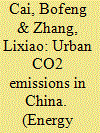| Srl | Item |
| 1 |
ID:
137668


|
|
|
|
|
| Summary/Abstract |
The belief that small hydropower (SHP) systems are sources of clean energy with few or no ecological problems has been driving the rapid expansion of SHP plants in China and elsewhere. This paper presents an evaluation of the ecological impacts of SHP based on an emergy analysis of a plant located in Guizhou Province in southwest China. The results suggest that periodic downstream drying-up of the river is the largest contributor to the induced ecological impacts in terms of emergy cost. In 2010, the ecosystem service losses caused by downstream ecosystem degradation totaled 2.35E+18 seJ, which accounts for 38% of the total emergy utilized in the annual operation of this plant. If such losses could be avoided, i.e., if the SHP operated as designed, SHP projects would produce relatively modest impacts on the environment. When the reaches downstream of the SHP plant are not affected, the environmental loading ratio (ELR) is 2.20 and the emergy sustainability index (ESI) is 0.93; however, the ELR increases to 3.82 and ESI decreases to 0.38 when river drying-up occurs. These results indicate that China should rigorously investigate potential ecological problems of SHP development and proceed with caution rather than readily believing unjustified assumptions.
|
|
|
|
|
|
|
|
|
|
|
|
|
|
|
|
| 2 |
ID:
128033


|
|
|
|
|
| Publication |
2014.
|
| Summary/Abstract |
Different names/concepts and therefore different spatial boundaries for cities in China are responsible for the conflicting and confusing results associated with urban CO2 emissions accounting. In this study, four types of urban boundaries, i.e., city administrative boundary (UB1), city district boundary (UB2), city built-up area (UB3) and urban proper (UB4), were identified and defined. Tianjin was subsequently selected as the case city to illustrate the different performances of CO2 emissions with respect to these four boundaries using a 1-km grid dataset built bottom-up by point-emission sources. Different urban boundaries can induce a difference in CO2 emissions as large as 654%. UB1 and UB2 are not the appropriate proxies for urban boundaries in the analysis of urban CO2 emissions, although UB1 is a widely adopted boundary. UB3 is a good representative of city clusters and urban sprawl in a certain region, whereas UB4 is the appropriate system boundary for such issues as urban CO2 emissions in light of landscape characteristics and pertinent human activities, as well as the comparability to counterparts in developed countries. These results provide sound policy implications for the improvement of urban energy management and carbon emission abatement in China.
|
|
|
|
|
|
|
|
|
|
|
|
|
|
|
|